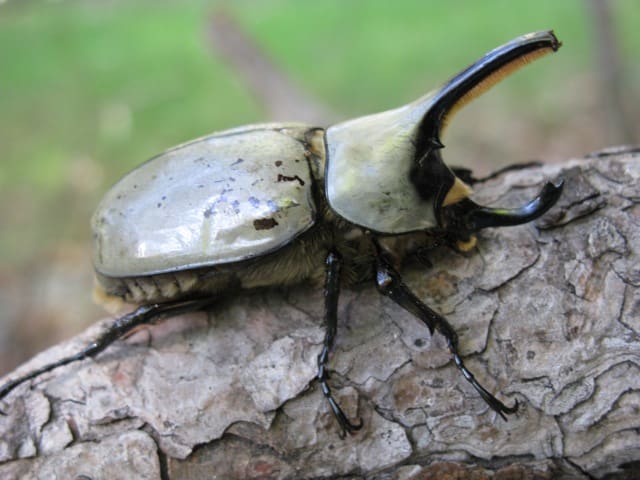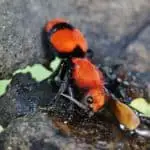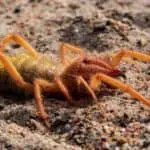Western Hercules beetle is one of the easiest pet insects to keep with a “set and forget” setup. In this article, I will teach you all you need to know about western Hercules beetle care and how to breed them.
Keep the grubs in moist flake soil and replace the spent flake soil every few months. They need around 2 years to turn into adults. Move the emerged beetle into a tank with a secure lid with some substrates. Feed it with beetle jelly. Transfer the gravid female into a separate tank for egg laying.
Introduction to Western Hercules Beetles

The western Hercules beetles are also known scientifically as Dynastes grantii, with double “i”. They are quite common in Arizona, and can also be found in New Mexico, Utah and northern Mexico.
The adult beetles have a distinctive gray color elytra (wings) with dark spots on it. They feed mainly on tree sap, while the grubs feed on decaying woods.
The male adults have 2 long horns, which are not in the female beetle. One of the horns is located on the thorax and hence called the thoracic horn, while the cephalic horn is located on its head. The western Hercules beetles have a longer thoracic horn than the cephalic horn, which sets them apart from the eastern Hercules beetles.
In captivity, adult western Hercules beetles can live 3-9 months. The size of adult male beetles is typically around 60-70 mm from the tip of its horn to the tip of its wing. The biggest captive-bred western hercules beetle was recorded in 2009 at 89.1 mm. Hobbyists are constantly striving to grow bigger beetles.
Western Hercules beetles make good pets because they are easy to care for, they don’t sting nor bite and they are not venomous.
Getting Western Hercules Beetles
There are 2 ways to get western Hercules beetles: buying vs catching. You can catch western Hercules beetles if you are staying in Arizona or where the beetles are present. Check out the distribution map of D. grantii for more information.
How to Catch Western Hercules Beetles
Prepare a big black light, a white bed sheet and some bottles. Find an open field near a forest and away from light pollution. At night, hang the white bed sheet somewhere and shine your black light onto the white sheet. Wait for the beetles to come and capture them using the bottles.
You can also build a trap to catch them. Get a bucket with a lid. Make a hole on the lid so that the beetles can go in. Put some cut fruits such as pineapples into the bucket and close the modified lid. Leave the bucket overnight and collect it on the next day. The lid will reduce the chance of any beetles captured being eaten by other animals and prevent the beetles from escaping.
Catching the western Hercules beetles in the wild requires perseverance and some luck. You might end up getting nothing, or you might also hit an unexpected jackpot by catching some rare species other than D. grantii.
Buying Western Hercules Beetles
Western Hercules beetles are quite common in the US, so you shouldn’t have any issue buying them from collectors or breeders. Even in Asia where this species is not native to, you will be able to buy captive-bred Western Hercules beetles from breeders.
You have 2 options when buying the western Hercules beetles: grubs versus adults. My personal advice is to go for grubs so that you can experience most of your beetle’s life cycle.
If you are eager to see your adult beetle, get the adult beetle directly. Most people will buy the more expensive male beetle if they go for an adult because of its cool-looking horns.
Grubs are much cheaper options than adult beetles, if you have the patience to wait until they turn into adults. Make sure you buy 2 or more grubs because not all will survive into adults.
Grubs can be sexed after reaching third instar. So, you will be able to buy a male grub if you want to.
You might find certain breeders selling captive-bred western Hercules beetles at a very high price. That’s because those beetles are specifically bred and selected to produce bigger and fitter breeds. You don’t have to buy those expensive breeds.
Western Hercules Beetle Care: Grubs
Substrates
Substrates are crucial for the growth and survival of your western Hercules beetle grubs because they live in and feed on the substrates. To rear the grubs, we use flake soil, which is essentially decayed hardwood.
Before using the flake soil, you need to make it adequately moist. Grubs cannot survive flake soils that are too dry or wet.
Mix the flake soil with tap water and stir the mixture evenly. Grab some moist flake soil in your hand and squeeze it. The flake soil should hold its shape momentarily when released but there shouldn’t be any water dripping. If the flake soil doesn’t hold its shape, add more water; if there is water dripping, add more flake soil until you achieve the ideal moisture.
You can buy flake soil from hobbyists or do it by yourself. I have a flake soil recipe that you can refer to.
Housing the Grubs
Find a plastic container with a screw cap. You can start with an 8 oz (250 mL) container and move to 0.5 gallon container once the grub reaches the third instar.
Poke a few holes on the upper wall of the container to allow ventilation. An unventilated container will promote the growth of molds.
Fill up the container with flake soil and lightly compress the flake soil. Finally put the grub onto the flake soil and close the cap. The grub will burrow deep into the flake soil.
The western Hercules beetle grubs can be housed individually in separate containers or housed together in the same container. You will need a bigger container if you want to house them together.
If you house them together, both male and female grubs will emerge at about the same time. This will allow you to breed them. Otherwise the male will emerge much later than the female. However, keeping them together will produce smaller individuals.
Temperature Control
If your aim is to grow large western Hercules beetles with long horns, temperature control is a must. You need to keep the grubs between 71-75 °F (~22-24 °C). Without doing this, likely the beetles will not grow long horns.
Changing the Spent Flake Soil
As the grubs feed on the flake soil, they produce dropping. When the droppings occupy more than 70% of the container, you need to change the flake soil. If the soil looks dry before that, you will need to mist some water to make it moist.
To change the flake soil, pour everything out from the container. I usually rinse the container with tap water and brush off the flake soil stuck on the wall to hopefully reduce the chances of mold. It might not be necessary but I just do it anyway.
Fill up the container with new flake soil and lightly compress it. Add some old flake soil on top and put the grub onto the old flake soil. The old flake soil is thought to “entice” the grub to dig in because it contains its pheromones. The old flake soil also contains some bacteria that can help the grub digest the flake soil better.
Grub Molting
The western Hercules beetle grubs grow by molting. They are extremely fragile when molting.
If you happen to see them molting when replacing the substrates, do not touch them. You might cause molting to end up with failure. Gently put them back into the container with the spent flake soil and change the flake soil after 1 week.
It is quite unlikely to encounter molting grubs, but it is very likely to encounter pupating third instar. A third instar which is about to molt becomes yellowish, and it is known as the pre-pupa stage. The yellowish color becomes more intense as the molt is imminent. The pre-pupa stage lasts for about 1 month before the actual pupation.
If you see your third instar grub in the pre-pupa stage, you can stop changing substrates.
Pupation and Emergence into Adults
Typically, it takes around 14-18 months for the third instar larva to turn pupa. The growth rate can be slower if you keep the grub under lower temperature and faster if you keep it warmer.
When it is about time to pupate, the grub will start building a pupation chamber using the flake soil and it’s dropping. It then pupates inside the pupation chamber.
You wouldn’t know whether your grub has built a pupation chamber. Hence, if you need to change flake soil when it is near the estimated pupation time, be very careful so that you don’t break the chamber. Use a spoon to slowly scrape out the flake soil. If you hit something hard, it could be the pupation chamber. Dig out the surrounding substrates to see if it is indeed the pupation chamber. If that’s the pupation chamber, stop digging and leave it there.
If you accidentally break the pupation chamber, don’t panic. There are still ways to save your beetle.
Leave the grub inside the pupation chamber and it will pupate soon. The pupa emerges as an adult beetle after 1 month. The emerged adult beetle stays in the pupation chamber for 1 month to harden its exoskeleton before breaking out from the pupation chamber.
Wild-caught grubs usually pupate between April and August, but captive-bred western Hercules beetles are acclimated to artificial rearing conditions and can pupate when they are ready.
It takes about 2 years for the western Hercules beetle to turn into an adult from egg. It is a long but worthy and satisfying wait. As mentioned earlier, if you don’t have the patience and perseverance, get an adult beetle directly.
A newly emerged adult beetle is dark brown in color. As it’s elytra dry up, the color turns gray. The elytra may turn dark again if the humidity is high.
Western Hercules Beetle Care: Adults
Put the adult beetle in a ventilated tank with a secure lid. Add some peat moss and a bark. Feed the beetle with jelly.
The width and length of the tank should be at least 2-3 times the length of your adult beetles, and the height should be at least the length of your beetle. You can check out my guide if you want to learn more about enclosure.
Fill the tank with about 1″ of peat moss or hay. This allows the beetle to hide inside if it wants to. Put a bark or anything solid for the beetle to grasp in case it turns upside down (which happens very often).
Male western Hercules beetles should not be housed with other males to prevent fighting. A male beetle can be housed together with 4-5 females.
The easiest way to feed the beetle is by using beetle jelly. The jellies can be easily stored in the fridge for months and last for a few days at room temperature. I usually give my beetle enough jelly that lasts for 3 days. Here’s a jelly recipe that you can refer to.
You can also feed the beetle with cut fruit. Put the fruit on a small plate so that your substrates last longer before you need to change it. Replace the fruit every day.
Adult beetles are nocturnal and hence don’t require additional lighting. Put them away from direct sunlight.
You should clean the housing and replace the substrates at least quarterly.
Breeding Western Hercules Beetles
I don’t recommend you to breed western Hercules beetles if you have not tried breeding other easier species such as the eastern Hercules beetles. This is because the eggs take up 7 months to hatch, making them vulnerable to failures. There is no harm trying though.
Put both male and female western Hercules beetles in the same enclosure and they will mate. You might want to let them mate multiple times to ensure successful mating.
After mating, move the female beetle out and put her into a 4 gallon tank with 4-5″ of moist flake soil. The moisture of flake soil should be slightly higher than what you use for grub. Continue to feed the gravid female with jelly.
Within a few weeks, the female will lay eggs inside the flake soil. She can lay around 50 to 100 eggs that resemble white beads. Remove the female beetle after she laid eggs.
The eggs can hatch as fast as 1 month, but most of them will hatch between 2-6 months! You need to make sure the flake soil is adequately moist but not too moist within the 6 months period or the eggs will either rot or desiccate.
Check the eggs once every 2 weeks and transfer any hatched grub into a separate container. This will prevent them from damaging the unhatched eggs.
Hobbyists sometimes transfer the eggs into individual containers instead.
Recommended Supplies
Here are my recommended supplies that you can consider for keeping western Hercules beetles. Note that I get a small commission when you buy the items through the links in this page. This helps me maintain the site without incurring additional costs to you.
Recommended Reading
If you want to learn more about keeping beetles (not just Hercules beetles), I recommend you to grab the book by Orin Mcmonigle titled The Ultimate Guide to Breeding Beetles (affiliate link). It contains comprehensive information on rearing various beetles including the rhinoceros, stag, flower, dung beetles, and many other beetles. Whether you are a beginner or expert in beetles keeping, this book definitely blows your mind. While it is not cheap, it is definitely worth the money!
Additional Information
How to Sex Western Hercules Beetle Grub?
Sometimes you might not be able to get sexed grubs when you buy them because they are too young. You will need to sex them by yourself after they grow into third larval instar.
To sex western Hercules beetles, look at the underside of their body. Male grub has an indentation at the center of the third-to-the-last abdominal segment on the underside of his body. This becomes obvious as the grub is closer to pupation. Females lack such indentation.


